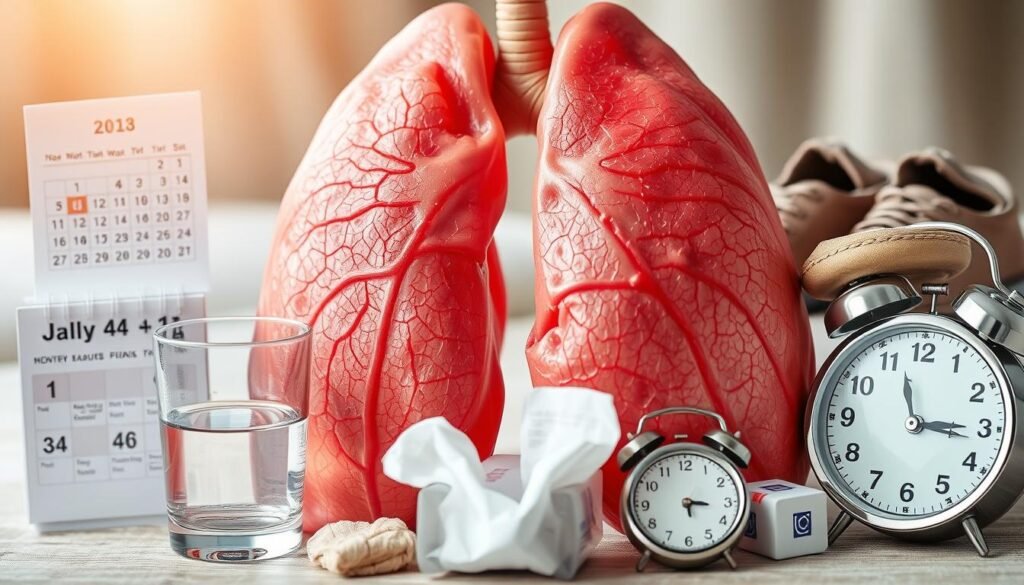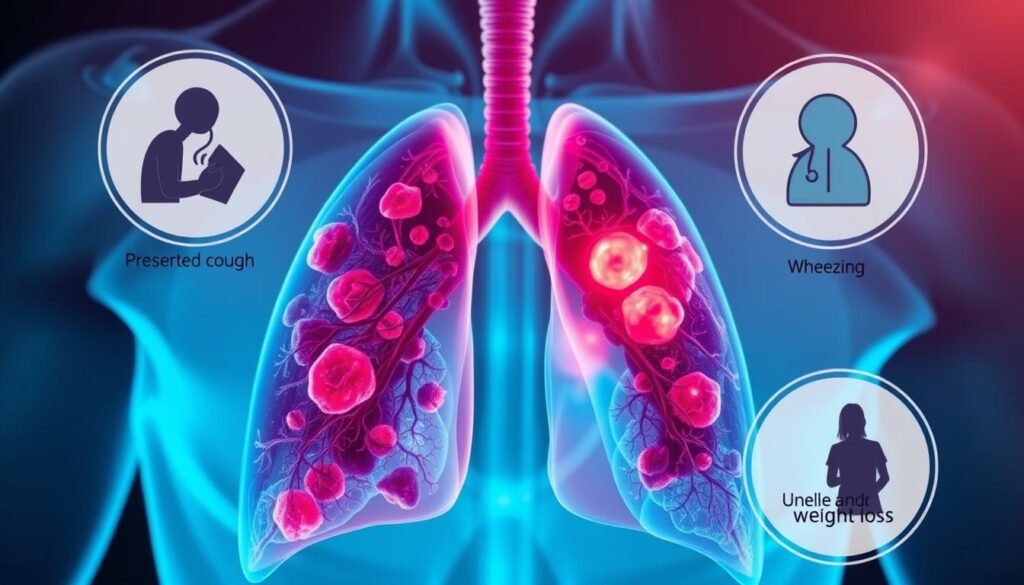Did you know lung cancer causes about 25% of all cancer deaths in the US? This makes it very important to know the early signs of lung cancer. Finding it early can greatly help in treatment and increase the chances of survival. Sadly, lung cancer often doesn’t show symptoms until it’s very advanced. This fact makes knowing the symptoms even more important.
Signs like a persistent cough or sudden weight loss can be key hints of lung cancer. It’s super important for people who are more at risk, like heavy smokers or those older than 55, to watch out for any weird or lasting changes in their breathing health. Being informed and proactive can empower you to seek early help and treatment. This can be a big help in dealing with this serious illness.
Key Takeaways
- Lung cancer accounts for 25% of all cancer-related deaths in the U.S.
- Early detection through routine screenings can visibly impact survival rates.
- Persistent cough and unexplained weight loss are significant warning signs.
- Individuals at high risk should consult healthcare providers about screening options.
- Awareness of lung cancer symptoms is crucial for timely intervention.
Understanding Lung Cancer
Lung cancer is a major health issue around the world. It’s the top cancer type, aside from non-melanoma skin cancers. There are two main kinds: non-small cell lung cancer (NSCLC) and small cell lung cancer (SCLC). NSCLC makes up about 85% of cases and grows slower than SCLC. SCLC, making up about 15% of cases, spreads quickly and is more aggressive.
Knowing the different lung cancer types is vital for finding and treating them. Smoking, asbestos, and air pollution are common risks for both types. Smoking is especially dangerous, causing about 90% of lung cancer cases.
Finding lung cancer early can greatly improve chances of survival. For example, the one-year survival rate for stage I lung cancer in England and Wales is 81.7%. But, it falls to 15.5% at stage IV. Knowing about lung cancer, its types, and how to prevent it can lead to earlier treatments and better outcomes.
| Type of Lung Cancer | Prevalence | Growth Rate | Common Risk Factors |
|---|---|---|---|
| Non-Small Cell Lung Cancer (NSCLC) | 85% | Slower | Smoking, Asbestos, Pollution |
| Small Cell Lung Cancer (SCLC) | 15% | Aggressive | Smoking, Air Pollution |
Why Early Detection is Crucial
Finding lung cancer early is key. It boosts the chances of beating the disease. At early stages, lung cancer is typically in one spot. This makes treatments like surgery more effective.
Late-stage lung cancer can spread and make treatment harder. That lowers the chances of survival. So, catching it early is critical.
In the U.S., lung cancer is very common but often found too late. Just 21% are spotted early. This fact shows we need to better recognize early symptoms. People who’ve smoked a lot and are between 50 to 80 should get scanned yearly.
The American Cancer Society suggests these scans because they can find cancer early. Early detection means treatments work better. Knowing and acting on early signs can save lives.

Common Early Signs of Lung Cancer
Spotting early lung cancer signs can really help with treatment. Symptoms might show the presence of this condition. It’s key to watch for these signs for early help.
Persistent Cough and Changes in Cough Patterns
A cough that stays or gets worse could mean lung cancer. It may be a dry cough or one that has blood. If coughing changes, it’s time to check it out.
Shortness of Breath: When to be Concerned
Feeling short of breath is important to notice. It might happen during normal things or when resting. Knowing when it’s hard to do usual activities can mark lung problems.
Weight Loss Without Trying
If you’re losing weight without trying, it could be serious. This happens without changing your diet. If this comes with other symptoms, get checked for lung cancer clues.
Recognizing Non-specific Signs of Lung Cancer
Lung cancer’s non-specific signs can make diagnosis hard. They often look like symptoms of other health problems. Knowing these signs helps catch lung cancer early, especially for high-risk people.
What Are Non-specific Symptoms?
Non-specific symptoms don’t point directly to one disease. For lung cancer, these can be:
- Prolonged fatigue
- Chest pain
- Unexplained weight loss
- Chronic cough
- Recurrent respiratory infections
These vague symptoms might be mistaken for minor issues. This can delay a lung cancer diagnosis. If you notice these signs, especially several at once or getting worse, see a doctor early.
Distinguishing Between Other Conditions and Lung Cancer
Distinguishing lung cancer from benign conditions can be tough because symptoms overlap. If you have these symptoms, think about:
- How long and how severe your symptoms are. If you have a lasting cough or chest pain, look into it.
- Your risk factors, like smoking or a family history of lung cancer, could make symptoms more worrying.
- Seeing a doctor if symptoms don’t go away as expected, like with bronchitis or pneumonia.

Keeping an eye on your health could spot problems early. Understanding non-specific lung cancer signs is key for getting help fast through timely diagnostic tests.
| Symptom | Common Alternatives | Consideration |
|---|---|---|
| Prolonged fatigue | Chronic fatigue syndrome, anemia | Seek evaluation if persistent |
| Chest pain | Musculoskeletal pain, heart issues | Consider medical advice |
| Unexplained weight loss | Thyroid issues, dietary changes | Important to investigate further |
| Chronic cough | Asthma, GERD | Consult if lasts more than a few weeks |
| Recurrent infections | Seasonal allergies, COPD | Requires medical assessment |
Specific Symptoms of Non-small Cell Lung Cancer
Spotting the symptoms of NSCLC early can greatly help in starting treatment sooner. Many patients share common symptoms that are key to recognizing the disease. Knowing these symptoms, especially the ones that appear in later stages, is critical. It can urge immediate medical care.
Typical Symptoms of Non-small Cell Lung Cancer
A persistent cough is the first sign of NSCLC for 65.0% of patients. Along with this, other symptoms include:
- Chest pain, especially when taking deep breaths, seen in 17.9% of patients.
- Shortness of breath, found in 17.0% of patients.
- Sputum mixed with blood, occurring in about 33.0% of people.
It’s vital not to ignore these NSCLC symptoms. Seeing a doctor quickly can lead to early treatment. Starting treatment early often means better chances of success. Discover more about these symptoms and early detection of NSCLC here.
Symptoms that Indicate Advanced NSCLC
When NSCLC reaches later stages, symptoms get much worse. Symptoms of advanced NSCLC include:
- Intense fatigue that hinders daily tasks.
- Lobar pneumonia, worsening breathing problems.
- Neurological symptoms like ongoing headaches and seizures, hinting at the spread of cancer.
People in advanced stages might face more chest pain, weight loss, and serious breathing issues. Those with squamous carcinoma in stage IV are often more affected by these severe symptoms. Early detection of these signs can lead to timely and more effective treatment options.
| Symptom | Initial Occurrence (%) | Advanced Occurrence |
|---|---|---|
| Chronic Cough | 65.0% | Increased severity |
| Chest Pain | 17.9% | Common in stage IV |
| Shortness of Breath | 17.0% | Worsens in later stages |
| Sputum with Blood | 33.0% | Can indicate metastasis |
| Severe Fatigue | N/A | Common in advanced NSCLC |
Signs of Small Cell Lung Cancer
Small Cell Lung Cancer (SCLC) is not as common as other types, but it’s still serious. Many early signs are easy to miss. For example, coughing a lot and feeling out of breath are common.

Pain in the chest and wheezing might also happen. These signs should not be ignored.
Other signs include having a hoarse voice or losing weight without trying. Even though these can be from other causes, they are still signs to watch for. Smoking is a main cause of SCLC. Being around secondhand smoke also raises your risk.
Small cell carcinoma is the most seen type of SCLC. Spotting the early signs of SCLC early can improve treatment success. There are tests, like chest x-rays and CT scans, that help find SCLC. If you see changes in your health, it’s important to see a doctor quickly.
SCLC affects not just those who have it, but their caregivers too. Caring for someone with SCLC can be very stressful. Research into these experiences can guide better support for patients and caregivers. Knowing these signs is key to catching SCLC early and treating it effectively. For more detailed information, visit this source.
At Home: Monitoring Subtle Lung Cancer Symptoms
It’s crucial to be proactive about health, especially with lung cancer symptoms. At home, monitoring respiratory health is key. Watch for any changes in your condition. Noticing slight symptoms of lung cancer early is important. They’re easy to miss. Keeping a record helps spot trends needing attention.
Keeping Track of Changes in Health
Using a health diary is wise for catching subtle lung cancer signs. Note down:
- Coughing patterns, including how long and intense
- Shortness of breath during everyday tasks
- Unexpected weight loss or feeling very tired
- Other odd symptoms, like constant pain or not wanting to eat
This tracking is crucial for watching lung cancer signs. It helps you and doctors make good choices.
When to Consult a Doctor
Knowing when to see a doctor is key for early care. A persistent cough, changing from dry to wet over two months, means it’s time. Also, look out for:
- Feeling wiped out all the time
- Spitting up blood or weird mucus
- Having more trouble breathing
- Losing weight without trying or not being hungry
Noticing these signs is the first step in taking action. Early action greatly improves chances against lung cancer.
Understanding Warning Signs of Lung Cancer Progression
As lung cancer gets worse, the signs become more obvious. Knowing these signs early is key to talking with doctors effectively. Patients with serious lung cancer symptoms should watch for certain signs.
- Increased bone pain: This means cancer might have spread to the bones.
- Jaundice: When the skin and eyes turn yellow, it suggests the liver might be affected.
- Swelling: Swelling can happen, especially in the legs and belly.
- Neurological symptoms: Headaches or vision changes can mean the brain is involved.
Keeping an eye on these signs can help catch things early, possibly making treatments work better. Knowing what to look for helps patients and caregivers take quick action. Talking about new symptoms with doctors is important for managing lung cancer at this serious point.
| Warning Sign | Description | Possible Implication |
|---|---|---|
| Increased Bone Pain | Pain worsening over time, often in weight-bearing areas | Potential metastasis to bone |
| Jaundice | Yellowing of skin and eyes | Possible liver metastasis |
| Swelling | Localized or generalized swelling in extremities | Fluid retention or metastasis |
| Neurological Symptoms | Frequent headaches or vision changes | Possible brain metastasis |
Knowing these signs helps people understand how lung cancer is moving forward. It’s vital for getting the right support and medical help in time.
Importance of Diagnostic Testing
Getting diagnosed early and accurately is key in battling lung cancer. Diagnostic tests are crucial for confirming lung cancer. They help pinpoint the disease and decide on the best treatment approach. Understanding these tests allows patients to make wise health choices.
Types of Tests for Lung Cancer Diagnosis
There are several tests used to find lung cancer. Each test has a different method and effectiveness:
- Chest X-rays: Often the first step to spot lung issues.
- CT Scans: Better than x-rays for seeing tumors and how far they’ve spread.
- MRI Scans: Great for finding if cancer has moved to the brain or spine.
- PET Scans: When used with CT scans, they’re good for determining the cancer stage and its spread.
- Bone Scans: Used to see if lung cancer has reached the bones.
- Needle Biopsies: Methods like Fine Needle Aspiration (FNA) and Core Needle Biopsy (CNB) are less invasive for getting tissue samples.
- Sputum Cytology: Good for spotting certain lung cancers, like squamous cell lung cancer.
- Bronchoscopy Procedures: Including mediastinoscopy and thoracoscopy, these help diagnose and check cancer spread.
Interpreting Test Results
Understanding lung cancer test results is vital. The results help know the disease stage and traits, guiding treatment choices:
| Test | Purpose | Outcome of Results |
|---|---|---|
| Chest X-ray | Initial assessment for lung abnormalities | Might indicate need for further imaging |
| CT Scan | Detailed tumor characterization | Identifies tumor size and potential metastasis |
| Biopsy | Confirms lung cancer diagnosis | Determines cancer type and stage |
| PET/CT Scan | Cancer staging and locating spread | Essential for developing a treatment plan |
Lifestyle Factors That Can Impact Lung Cancer Risk
Lifestyle choices significantly impact the risk of lung cancer. Smoking is the biggest factor, causing most lung cancer deaths. Smokers are 15 to 30 times more likely to get lung cancer compared to non-smokers. Even smoking occasionally is risky.
Being around smoke from others is dangerous too and is a leading cause of lung cancer in the U.S. Radon exposure is another top cause, especially for non-smokers. Working with substances like asbestos, arsenic, and diesel exhaust also increases lung cancer risk. Those exposed to asbestos are much more likely to develop lung cancer.
But, smoking isn’t the only cause of lung cancer. Having a personal or family history of lung cancer increases your risk too. This is especially true if you have close relatives with lung cancer and you smoke.
To reduce lung cancer risk, living a healthy lifestyle is key. Exercise regularly, eat well, and avoid pollutants. Making these healthy choices can lower the chance of developing lung cancer. For more tips, visit this resource.
Conclusion
Noticing early signs of lung cancer is key to better health results. Lung cancer is the third most common cancer and leads in cancer deaths in the U.S. More people knowing about lung cancer can really help save lives. It’s crucial to know both specific and vague symptoms to catch the disease early.
For better treatment success, people need to watch for small changes in their health. They should see a doctor if they find anything odd. Early detection of lung cancer can lead to better treatment choices. This is vital since most cases are found too late, making treatment harder.
To fight lung cancer, being proactive about health can change lives. People at risk can live healthier by spotting the disease early and learning about their risks. Taking steps towards awareness, screening, and healthier living is essential in this fight.